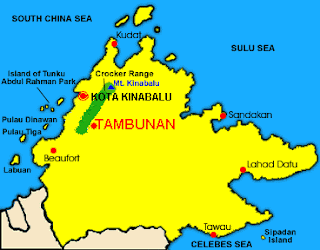Tambunan is a valley district located in the Interior Division of the state of Sabah. The district covers an area of 1,347 sq. km..[1] Its population was estimated to be around 27,852 in 2000, based on the 2000 Population and Housing Census conducted by the Department of Statistics, Malaysia.[2]. Almost the entire population are Dusun,[3] while the rest are Malay, Chinese and other Sabahan ethnic groups. It is located 80 kilometers east of Kota Kinabalu, 48 kilometers south of Ranau and 48 kilometers north of Keningau. At an average altitude of 750 meters, this valley, which is part of the Crocker Range, experience mild tropical climate all year long. The valley is peppered by terraced padi fields and 70 picturesque villages. The dense forests of bamboo around Tambunan are a legacy of the British colonial period, during which time an edict stated that 20 bamboo sprouts had to be planted for every bamboo cut.
Paddy fields in Kampong Tinompok, Tambunan
Tambunan is connected to Kota Kinabalu via the Kota Kinabalu-Tambunan-Keningau Highway.
East of Tambunan is Sabah's second highest mountain, Trus Madi (2642 meters).
The Mat Salleh Memorial, located in the middle of paddy fields at Kampung Tibabar, is a concrete structure erected in memory of Datu Paduka Mat Salleh. Better known as Mat Salleh, he led a rebellion against the British North Borneo Company in the late 19th century. The rebellion against British rule was due to the locals' dissatisfaction on alleged exploitation by the Company. He was killed in a gun battle with the British police on 1 February 1900. In recognition of Mat Salleh as one of Sabah's earliest freedom fighters, the State Government of Sabah built the memorial fort at the exact site of where he was killed.
Near the Mat Salleh's fort is the Tun Datu Mustapha Memorial the famous Sabah statesman.
Tambunan is noted for the quality of its Lihing and Tapai, or rice wine.
Outside of Tambunan is the Rafflesia Forest Reserve, devoted to the world's largest flower, the Rafflesia.
The road north of Tambunan to Ranau is considered one of the worst in Sabah, with numerous patches broken gravel, fallen roads and precarious water-filled ledges. The conditions have deteriorated due to increasing numbers of sinkholes and landslides and the slow rate of repair.











